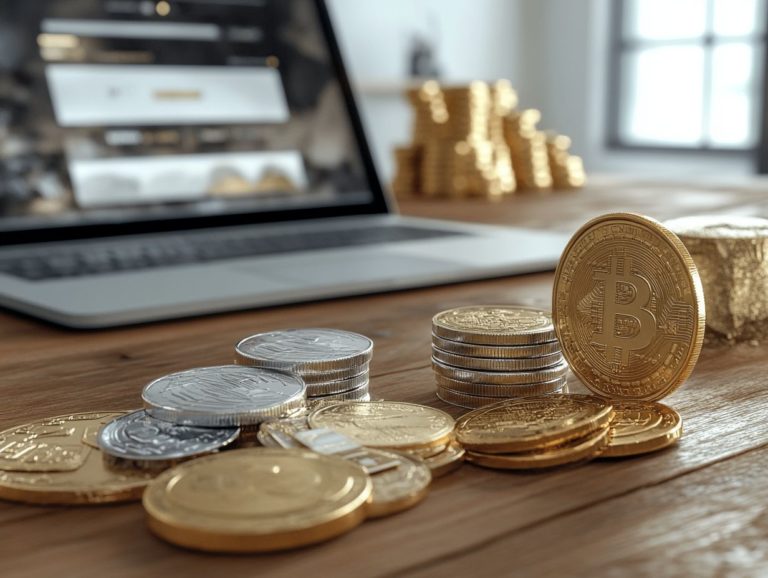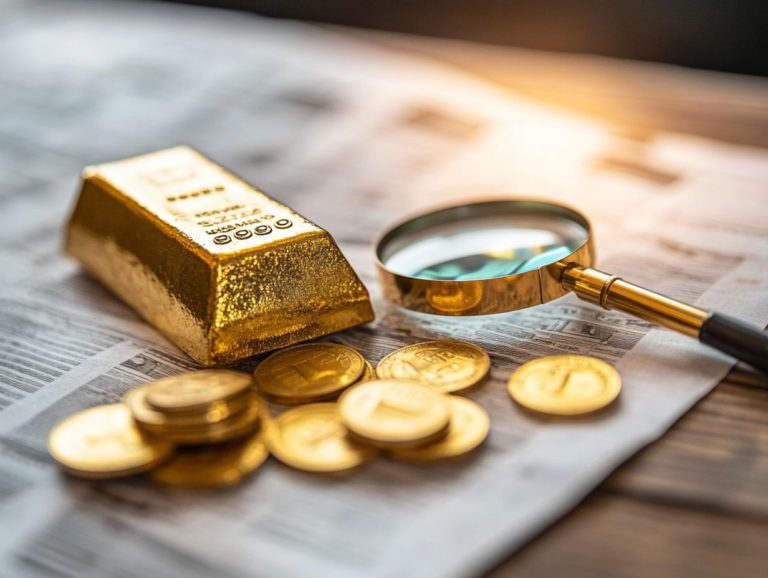Understanding the Tax Implications of Precious Metals
Navigating the world of precious metals can be thrilling yet complicated. Understanding the tax implications is crucial for your investment strategy.
This guide covers essential concepts like capital gains tax and reporting requirements. You’ll be equipped with the knowledge needed to make informed decisions.
Explore various investment types and their unique tax considerations. Discover strategies to minimize liabilities and maximize benefits.
You will also find insights into future trends in precious metals and taxes. This information will empower you to confidently navigate your investment journey.
Contents
- Key Takeaways:
- Defining Precious Metals
- Taxation of Precious Metals
- Investing in Precious Metals
- Tax Strategies for Precious Metals
- Future Outlook for Precious Metals and Taxes
- Frequently Asked Questions
- What are precious metals?
- What are the tax implications of owning precious metals?
- Do I need to pay taxes on my precious metals investments?
- Are there any tax-free options for investing in precious metals?
- What is the difference between a collectible and an investment-grade precious metal?
- What Happens If I Inherit Precious Metals?
Key Takeaways:
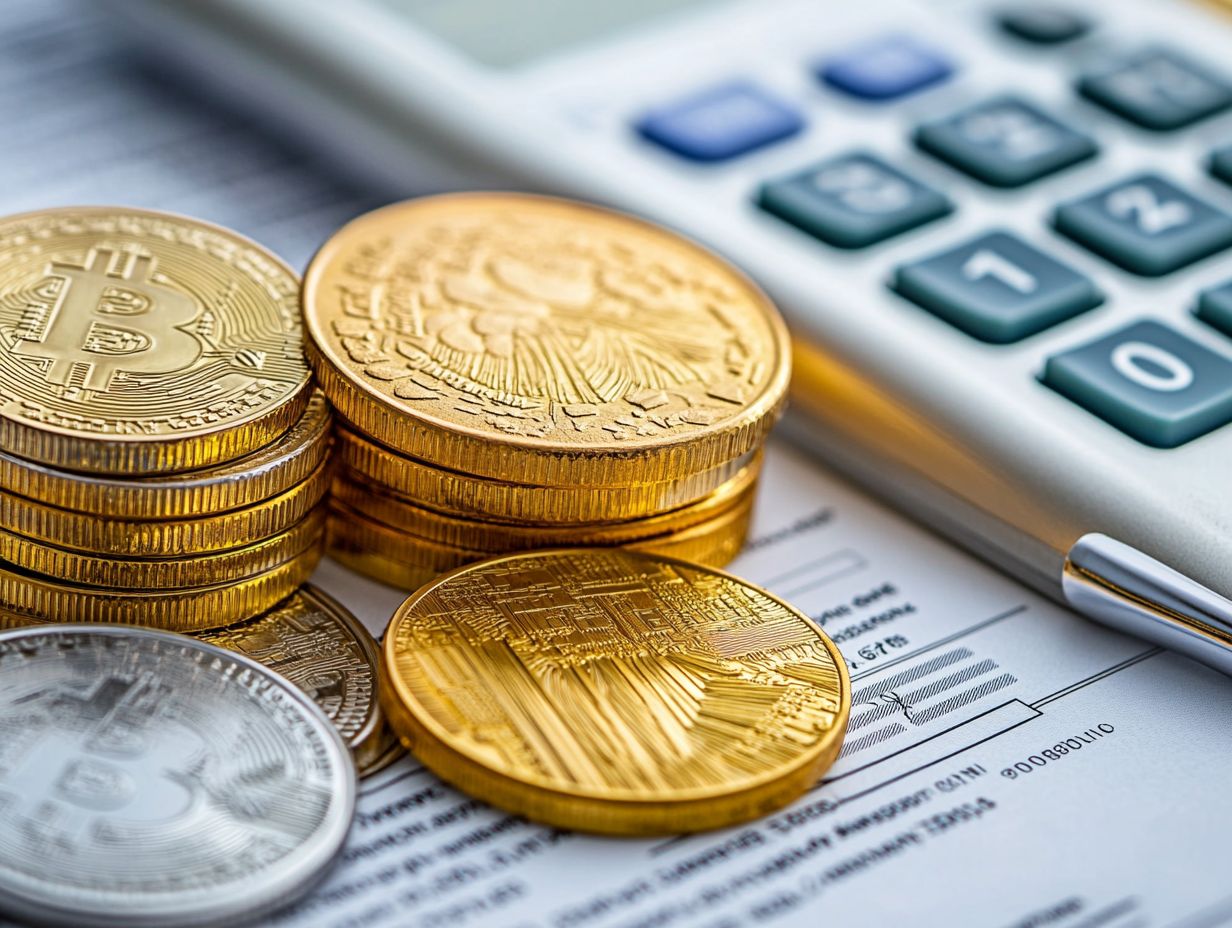
Precious metals, like gold and silver, are subject to capital gains tax when sold at a profit. They can also offer tax benefits as a hedge against inflation.
Understanding these tax implications is vital for effective investing. Different metals and investment methods can lead to varying tax consequences.
Defining Precious Metals
Precious metals, especially gold, are valuable assets known for their stability. They serve as a hedge against inflation and market fluctuations.
You can invest in these assets in several forms, including physical bullion, ETFs, and collectibles. Think American Gold Eagles or Canadian Gold Maple Leafs.
Understanding these options is important for diversifying your portfolio effectively.
Taxation of Precious Metals
The IRS has specific rules regarding the taxation of precious metals, like gold. These rules can significantly impact your tax planning and overall tax liability.
It’s important to understand the capital gains tax tied to selling precious metals. This knowledge will help you manage your investment profits wisely.
Capital Gains Tax
Capital gains tax is the tax on profits from selling investment assets, including precious metals. The IRS categorizes these gains as short-term or long-term based on how long you hold the asset.
Short-term gains are taxed at higher rates, impacting profit margins. In contrast, long-term gains, for assets held over a year, enjoy lower tax rates, benefiting those who invest longer.
Understanding these taxes can influence your decisions on buying, holding, or selling. Careful tax planning is vital for optimizing your financial returns.
Reporting Requirements
If you invest in precious metals, you must follow specific IRS reporting requirements. This includes documenting sales and assessing potential tax liabilities.
Not complying with these rules can lead to penalties. It’s crucial to keep precise records of all transactions to meet IRS standards.
Any gains from sales may need detailed disclosure, stressing the importance of diligent record-keeping. Familiarizing yourself with necessary forms helps you navigate tax compliance effectively.
Investing in Precious Metals
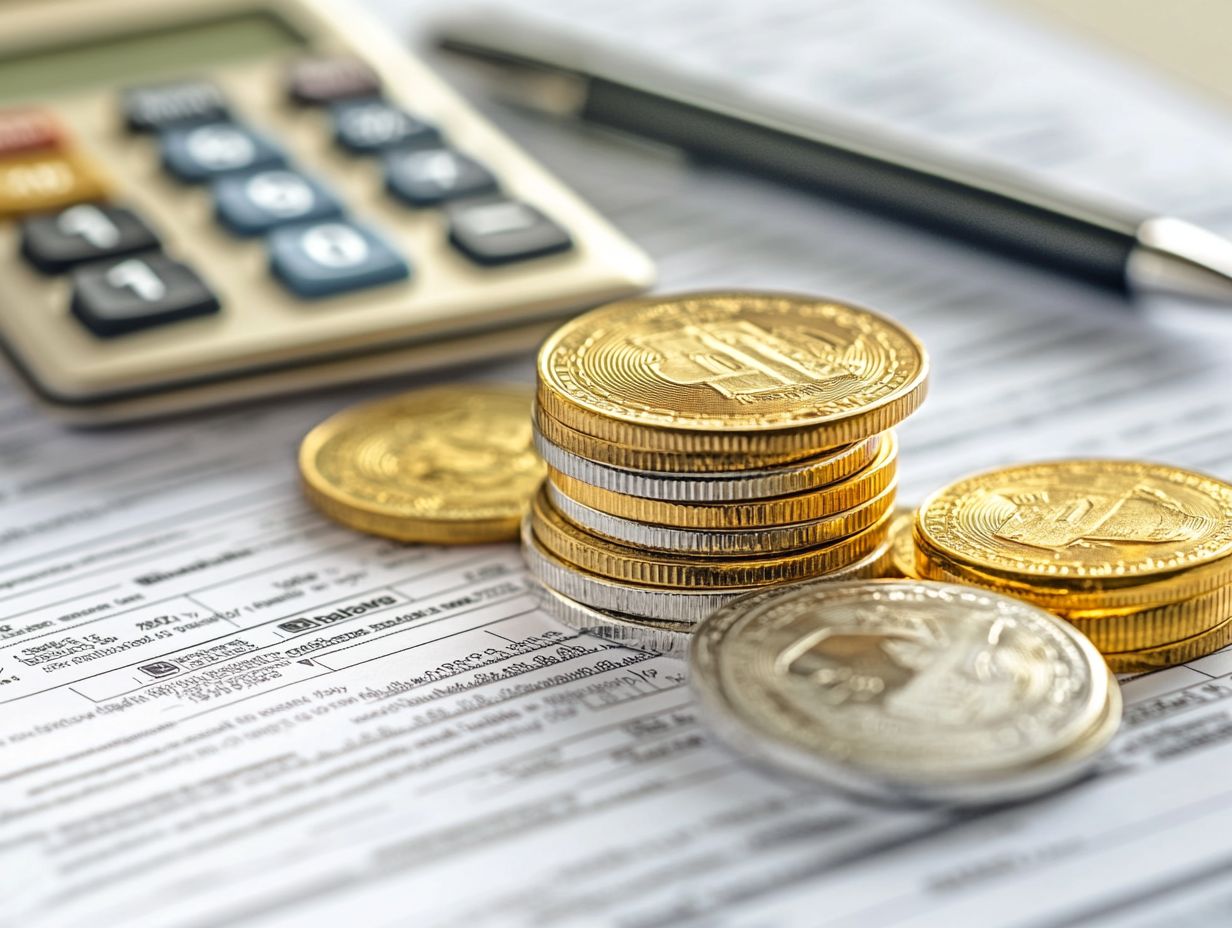
Investing in precious metals offers a unique opportunity to diversify your portfolio. You can leverage various strategies, including acquiring physical assets like gold, ETFs, and collectibles.
Each approach has distinct advantages and considerations, especially regarding market dynamics and your financial goals.
Types of Precious Metals to Invest In
When you think about investing in precious metals, gold often comes to mind first due to its allure and historical significance. However, don t overlook other options like silver, platinum, and palladium, which also offer excellent investment opportunities through ETFs and collectibles.
Each of these metals has unique qualities that attract different investment strategies. For instance, silver is not only admired for its aesthetic appeal and industrial applications; its lower entry price makes it accessible to a wider range of investors.
Platinum is rarer and typically more expensive than gold, but it is favored in various industrial sectors, which can significantly influence market demand. Then there s palladium, which has gained attention recently due to its essential role in automotive catalysis, making it a potential hedge against economic fluctuations.
By understanding these differences, you can navigate the market confidently and diversify your investment portfolio effectively.
Tax Considerations for Different Investment Methods
Tax considerations can vary greatly depending on the investment method you choose for precious metals. Different structures, such as direct purchases of physical assets or ETFs, can lead to unique capital gains and tax liability implications.
For example, if you invest directly in physical gold or silver bars, you may face capital gains taxes that depend on your holding periods and overall income brackets.
If you choose exchange-traded funds (ETFs) focused on precious metals, be aware that different regulations may apply, which could influence your overall tax strategy.
Collectibles, such as rare coins, have their own specific tax rules, often resulting in higher rates due to their classification.
You need careful planning to navigate these tax rules. This can help you optimize returns and stay compliant with tax laws.
Tax Strategies for Precious Metals
Now is the time to implement effective tax strategies for precious metals. Doing so is crucial for minimizing taxes and enhancing your investment profits within your wealth management approach.
By understanding capital loss and leveraging specific tax advantages, you can improve your overall tax situation and maximize your returns.
Minimizing Tax Liabilities
Minimizing your tax liabilities from precious metals investments requires strategic planning. You must adeptly navigate the capital gains regulations established by the IRS and manage your investment profits effectively.
Enhancing your tax efficiency can be achieved through various techniques. For example, consider tax-loss harvesting to offset gains or putting your investments in tax-deferred accounts like IRAs.
It s also important to weigh the implications of long-term versus short-term capital gains based on your holding periods. Staying informed about the latest IRS regulations is essential since they can significantly impact your overall tax strategy.
Consulting with tax professionals or financial advisors who specialize in precious metals can be incredibly beneficial. They can help you uncover opportunities for deductions and credits that might reduce your overall tax burden.
Maximizing Tax Benefits

Maximizing tax benefits from your precious metals investments can be achieved through various strategies. These include leveraging capital losses and utilizing individual retirement accounts (IRAs) as part of your wealth management plan.
By navigating these methods carefully, you can improve your financial health while reducing your tax burdens. For instance, timing your asset sales to take advantage of market fluctuations can help you offset gains with losses from other investments.
Incorporating these investments into self-directed IRAs not only provides tax-deferred growth but also allows you to hold a wide range of precious metals, such as gold and silver, efficiently.
Using these tactics wisely can position your portfolio for long-term success while maximizing the rewards from effective tax planning.
Future Outlook for Precious Metals and Taxes
The future of precious metals is exciting and full of possibilities! Emerging trends suggest that the IRS will keep a close watch on this market.
As investment strategies change, your approach to taxation might also shift in 2023 and beyond. Staying informed will be crucial as these developments unfold, possibly reshaping your investment landscape.
Predictions and Implications for Investors
Predictions about the precious metals market signal a growing demand, which could greatly influence your investment strategies and tax planning. Economic uncertainties and inflation trends might draw you to this sector as a safeguard against market volatility.
Analysts recommend diversifying your portfolio with precious metals like gold and silver, especially during uncertain times. It’s essential to monitor market signals actively and adjust your portfolio to benefit from price movements.
Understanding the tax implications of buying and selling these assets is vital for optimizing your returns and ensuring compliance with regulations.
Frequently Asked Questions
What are precious metals?
Precious metals are rare, naturally occurring elements valued for their rarity and physical properties. Examples include gold, silver, platinum, and palladium.
What are the tax implications of owning precious metals?
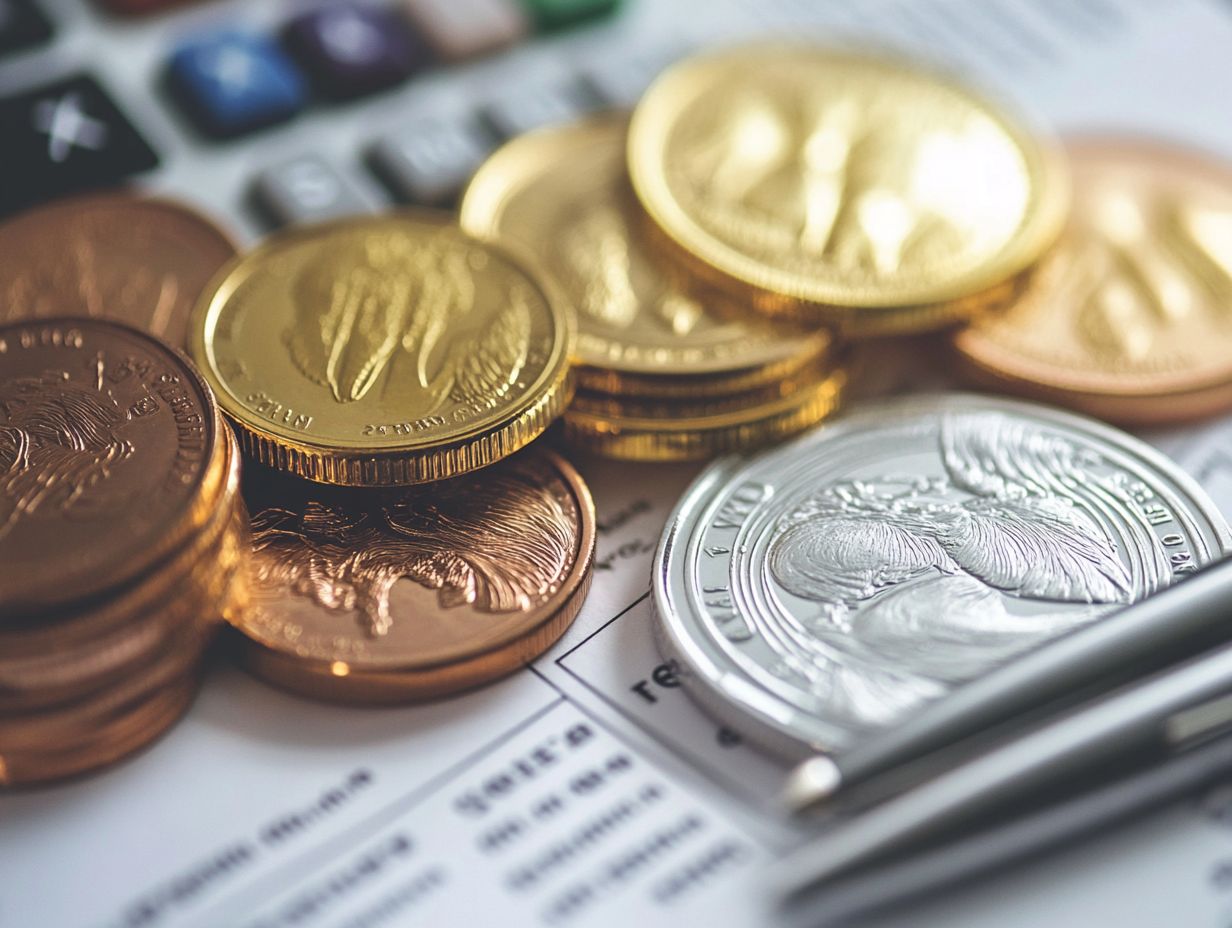
The tax implications of owning precious metals can vary based on the specific metal and how it is held. Generally, holding precious metals physically is treated as a personal investment and may be subject to capital gains tax when sold. However, certain tax benefits and exemptions are available for specific types of precious metals investments.
Do I need to pay taxes on my precious metals investments?
Yes, in most cases, you will need to pay taxes on your precious metals investments. This includes capital gains tax when selling the metals and potential taxes on any income earned from the investment. It’s important to consult with a tax professional to understand your specific tax obligations.
Are there any tax-free options for investing in precious metals?
Yes, there are tax-free options available for investing in precious metals. For example, certain retirement accounts, like a Roth IRA, allow for tax-free growth and withdrawals on investments in precious metals. Additionally, holding precious metals in a storage facility may also provide tax-free benefits.
What is the difference between a collectible and an investment-grade precious metal?
A collectible precious metal is valued for its aesthetic or historical significance and is typically held for personal enjoyment or display. In contrast, an investment-grade precious metal is primarily purchased for its intrinsic value as a financial asset. This distinction can affect the tax treatment of the metal, as collectibles may be subject to higher tax rates.
What Happens If I Inherit Precious Metals?
Inheriting precious metals can have different tax effects. These effects depend on the metals’ value at the time of inheritance and how they are handled in the estate.
For high-value inheritances, estate taxes may apply. If you sell the metals later, you might face a tax on the profits.
It’s wise to talk to a tax expert for tailored advice on your specific situation. Understanding these details can save you money and trouble down the road!

